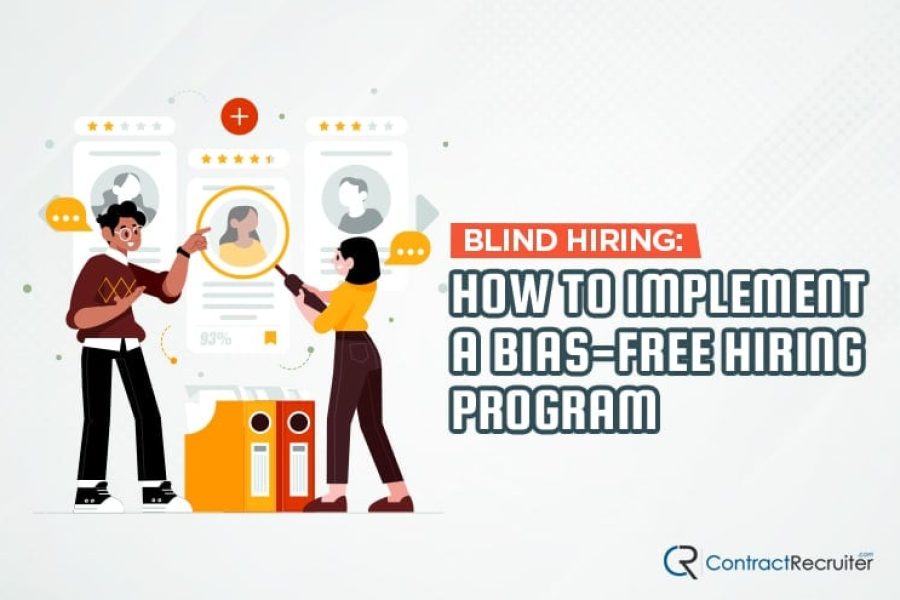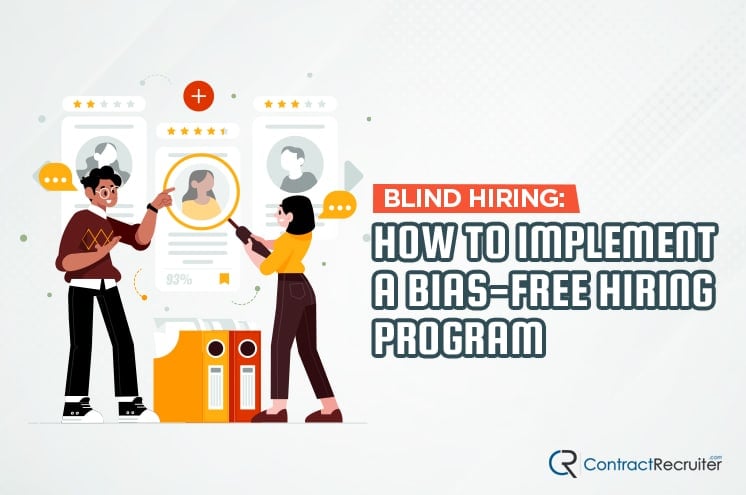We’ve written quite a bit recently about bias in hiring. To sum up:
- Bias can take many forms, many of which are unconscious.
- Bias can be inherent to systems used; an ATS is not guaranteed to be without bias.
- Working to eliminate bias from the hiring process helps increase workforce diversity.
It’s a complicated topic, with many strategies and considerations that are relevant to the hiring process. You want to minimize bias, though it’s impossible to remove entirely. Indeed, sometimes, removing one form of it introduces another.
Luckily, some forms of bias are much easier to remove or counteract than others. One way to remove these “low-hanging fruit” biases is to implement a blind hiring process. What is it, and how can you do it? Read on to learn more.
What is Blind Hiring?
When hiring for an open role, you have to process your list of candidates and filter it down to the best possible people for the job. How do you do that?
Often, you will start with broad filters. Anyone who doesn’t list the skills required for the role, doesn’t meet the experience minimums, or lacks required qualifications (such as a security clearance) can easily be eliminated from the running.
However, that still leaves you with a large candidate pool. You need to prune it down somehow. So, perhaps you start eliminating candidates based on less relevant factors.
Unconscious bias can manifest in choosing who you remove from the candidate pool. For example, you might remove someone you get a bad “gut feeling” about, despite having no data to back it up. This gut feeling could be based on something in their resume, but it could also be as simple as not liking their name.
A common form of bias is associative bias. Imagine for a moment that you had a childhood bully named Tom. When it comes time to make your hiring choices, you find a candidate named Tom and remove them from the running because you have a bad feeling about them. Nothing about their resume indicated they were a bad fit; you simply have negative emotions tied to their name.
This applies to more than just associative biases. Another common form of bias is eliminating candidates with “foreign” names, which is typically a form of racial bias. Many hiring managers will unconsciously pick Tom when choosing between Tom and Muhammad, even if both resumes are identical.
So, what if you remove the names from resumes? In doing so, you can remove name-based biases.
This is a basic form of blind hiring.
- Identify pieces of information that are not relevant to the hiring decision but are present on a resume.
- Remove those pieces of information from the candidate’s file, and make your determinations based on what remains.
- Once a candidate has passed the initial screenings and filters, you can return access to that information as necessary (such as needing their address to send paperwork or their name to address them in a phone interview.)
Typically, blind hiring is implemented early in the screening process when more personal information isn’t necessary.
For example, if you ask an applicant to take a skills assessment, you can judge them based on their performance in that assessment. Anyone who doesn’t pass it can be removed, regardless of their personal information. Anyone who does can move on to more personal interviews or other screening.
What Information is Removed in Blind Hiring?
Generally, the information removed in blind hiring has to meet two criteria. First, it is related to personal, protected information, usually the kind of information that is protected by labor laws. Second, it must be information not relevant to the hiring decision. What kind of information might this be?
Name. One of the most common forms of unconscious bias is bias against names outside the hiring manager’s typical societal experiences. This is often tied to racial bias as well. “Ethnic” names, or names from cultures outside of the regional culture, are often suppressed.
Ethnicity/Race/Nationality. While most job application processes don’t ask for ethnicity, if a candidate has a photo attached to their resume, or if you look them up on social media, it can come up. While national citizenship can be relevant for hiring later in the process (such as if a work visa is needed), it is irrelevant to the early screening phases.
Gender. Despite widespread equal rights movements and social pressure towards equality – and companies claiming to make commitments to that effect – gender is still a basis for hiring discrimination. Gender segregation is still widespread throughout hiring and work.
This doesn’t even begin to get into non-traditional gender identities, including trans candidates, non-binary candidates, or agender candidates. Gender should not be considered in hiring and should thus be removed from the early screening process as part of blind hiring.
Education. While a minimum amount of higher education may be significant to the hiring decision, the candidate’s school choice is not. Studies have shown that attending a prestigious university is not necessarily a predictor of job performance or success. It’s often more of a sign of nepotism and family connections than anything. Additionally, using educational institution can be a form of racial bias when you consider that there are many educational institutions that are predominantly black, for example.
So, while you can judge an individual based on whether or not they achieved a degree of higher education, you should not judge them based on what school issued it. Even companies like Google are removing this information from their hiring process.
Age. One of the more overlooked categories in the protected attributes list is age. While age can potentially tie into experience levels, it is not a primary determining factor and should not be considered. Age discrimination against the young and the old is highly detrimental to a diverse workforce.
Personal Interests. Some candidates may list their hobbies or personal interests on their resumes or as part of their applications. This information is largely irrelevant to the hiring process and a way to potentially discriminate in hiring. A simple bias might be “this person likes reading, so they must be smart” or assigning more or less value to certain hobbies that are traditionally relevant to women or minorities. Does someone preferring woodworking or knitting impact your choice to hire them? It shouldn’t.
Location. Location can be tied to discrimination based on, among other things, socio-economic status. Judging a candidate based on their location – even as broadly as zip code – can become a form of discrimination. Redlining and other geographic segregation of minorities (and income levels) is a real problem in many cities.
We also live in a globalized society, where the nature of work can mostly be done remotely. Location may only come into play when you consider in-country versus out-of-country. Even then, it’s more relevant to the paperwork involved in finalizing a hire than it is in their initial consideration.
How to Implement Blind Hiring
The actual process for implementing blind hiring will vary from organization to organization. You need to determine what information is relevant and what isn’t and how to filter it.
The easiest way to implement blind hiring is to use a hiring platform that includes it built-in. Such platforms include:
- Toggl Hire
- GapJumpers
- Blendoor
- Entelo Diversity
- Pymetrics
- Textio
- FairHire
Today, many – if not most – applicant tracking systems have blind hiring methodology built into them.
Smaller businesses that don’t want to invest in an ATS might instead use spreadsheets to aggregate information about candidates and hide or remove data fields that include irrelevant information. It’s more manual work but can be just as effective.
Remember, blind hiring is generally best as part of the initial screening, not a later phase of the hiring process.
You should also determine which pieces of information should be removed. Some platforms remove more than others, and some allow you to customize what you remove. Consider the list above.
Another key to a successful blind hiring process is removing sources of bias before the candidate even enters your orbit. Specifically, you want to write a neutral and bias-free job posting. This can involve replacing traditionally masculine language with gender-neutral language and removing “requirements” that are not genuinely required for success in the role.
You might be thinking, “this doesn’t leave much information to judge a candidate,” and you may be right. Thus, you will want to implement an additional, unbiased way to screen candidates. One standard option is to implement a skills assessment. The ability to judge a candidate based on their performance in tasks they would be doing in the actual job is invaluable to any hiring process.
Some organizations also progress to anonymized initial interviews. These interviews may be conducted via a live chat or using one-way non-video interview questionnaires, though this is both more difficult and less valuable as an initial screening filter.
Finally, you will want to track employee performance using this hiring process. For obvious reasons, you want to improve outcomes in terms of employee loyalty, performance, and success in their role; if your blind hiring process suppresses positive results, you need to analyze the situation and find out why, so you can solve the problem.
Are There Drawbacks to Blind Hiring?
In truth, blind hiring is not a perfect system.
For one thing, it can only genuinely apply to the early phases of candidate screening. After that point, it becomes unavoidable to learn things like your candidate’s name, ethnicity, or gender presentation. To ensure that these qualities do not impact hiring, you need additional safeguards, such as:
- Bias training for your HR staff to build awareness and strategies to minimize bias.
- Interview scorecards to provide a standardized and more objective rating for candidates.
- Multi-person interviews to reduce the impact of an individual’s unconscious bias.
Additionally, blind hiring can get in the way of some diversity initiatives. For example, removing demographic information may lead to considerable difficulties if your company aims to hire more minority candidates.
On top of that, if you don’t appropriately adjust your job postings, you may find your initial candidate pool – even subject to anonymization – can be skewed.
“Some research has shown that making applications anonymous can have the reverse effect for minority groups, as this blocks the efforts made by affirmative actions. For example, one study found that anonymous hiring reduced the likelihood of women getting callbacks, as this anonymity “prevented the use of positive measures aimed at improving the representation of women.”” – Glassdoor
Blind hiring is just one tool among many that helps build a less biased hiring process.
Should Your Company Invest in Blind Hiring?
Generally, yes. A blind hiring process helps to remove some easy forms of bias. However, it is not without context. Any system used for blind hiring is part of an overall hiring process and ecosystem. If your job posting, your company culture, or a machine learning algorithm are themselves biased, a blind hiring process will not be able to counteract that bias.
Removing bias and creating a more diverse workforce has tangible benefits to most companies. Diverse teams consistently out-perform less diverse teams in every context and well-formed study looking into the subject. Companies emphasizing diversity also see higher profits, better outcomes, more engagement and loyalty, and better customer retention.
There is no substitution for constant awareness, training, and review. Blind hiring can be one part of a more comprehensive solution, but it is not a complete solution itself. Implementing a blind hiring process can be highly beneficial, but only as part of a thorough dedication to diversity throughout the company.
Do you or your company have any questions about blind hiring or how you can implement it into your hiring process? If so, please feel free to leave a comment down below, and we’ll get a conversation started. Changing up how your hiring process works might not be an easy task for every company, so we would be more than happy to assist you by answering any of your questions or clearing up any concerns that you may have.








